YOJANA October 2024
Chapter 1: Impact of Rural Sanitation & Smart Approach for Sustained Sanitation
Sanitation in India has a deep-rooted history, with advanced waste management systems dating back to the Indus Valley Civilization. Despite this legacy, modern India struggled with inadequate sanitation, particularly in rural areas. By 2014, only 39% of the population had access to proper sanitation facilities, with open defecation (OD) posing significant health and safety risks, especially for women and children.
Key Sanitation Programs Pre-2014
- Central Rural Sanitation Programme (1986): Focused on toilet construction.
- Total Sanitation Campaign (1999): Emphasized creating demand through Information, Education, and Communication (IEC).
- Nirmal Bharat Abhiyan (2012): Adopted community-led approaches to sanitation.
Swachh Bharat Mission (SBM)
- Launched on October 2, 2014, by Prime Minister Narendra Modi, the Swachh Bharat Mission (SBM) marked a transformative shift in India’s approach to sanitation.
- It aimed to make India Open Defecation Free (ODF) by 2019 and achieved its goal on time. SBM focused on behavior change, community participation, public financing, and political will.
Impact of Swachh Bharat Mission (SBM)
- Health Impact: Poor sanitation caused widespread waterborne diseases like diarrhea, cholera, and typhoid. Before SBM, inadequate sanitation led to around 3 lakh child deaths annually. Post-SBM, 60,000-70,000 child deaths have been averted annually.
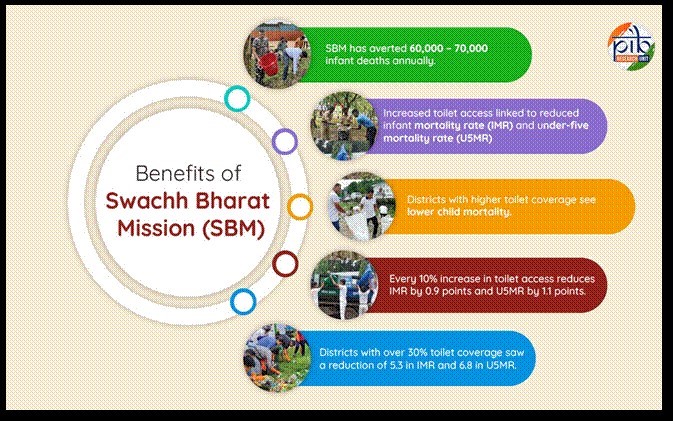
- Impact on Women and Children: Lack of toilets disproportionately affected women, exposing them to harassment. Girls missed school during menstruation due to poor facilities. SBM improved safety and dignity, and reduced child malnutrition by improving overall sanitation.
- Environmental Impact: Open defecation and waste mismanagement polluted water bodies and soil. SBM reduced the likelihood of groundwater contamination in ODF villages by 12.7 times.
- Economic Impact: Poor sanitation cost India 6.4% of its GDP in 2006. SBM resulted in savings of Rs 50,000 annually per household in ODF villages by reducing health expenses.
SBM and the Sustainable Development Goals (SDGs)
- The Swachh Bharat Mission (SBM) aligns closely with the Sustainable Development Goals (SDGs), particularly SDG 6: Clean Water and Sanitation.
- India achieved Open Defecation Free (ODF) status in 2019, 11 years ahead of the global 2030 target. SBM contributed by constructing over 116 million household toilets, directly addressing Target 6.2 on ending open defecation.
- SBM also supports:
- SDG 3 (Good Health and Well-being) by reducing waterborne diseases and child mortality, averting 3 lakh child deaths annually (WHO).
- SDG 5 (Gender Equality) by providing safe, private sanitation for women, improving dignity, safety, and reducing school absenteeism for girls (UNICEF).
|
Sustainable Development Goals (SDG): The Sustainable Development Goals (SDGs) are a set of 17 global goals established by the United Nations as part of the 2030 Agenda for Sustainable Development, adopted by all 193 Member States in 2015. |
India’s early achievement showcases strong political leadership, community mobilization, and effective program design as a model for global sustainable development.
SBM Phase II (2020-2025)
The Swachh Bharat Mission (SBM), which initially focused on ending open defecation, expanded its scope in Phase II (2020-2025) to ensure sustainability and address broader sanitation challenges. Key focus areas include:
- ODF Sustainability: Maintaining Open Defecation Free (ODF) status through regular monitoring, community engagement, and retrofitting toilets where necessary.
- Solid and Liquid Waste Management (SLWM): Promoting household/community compost pits, waste stabilization ponds, and adopting waste-to-energy technologies to reduce environmental degradation.
- Visual Cleanliness: Ensuring litter-free public spaces, proper drainage, and waste segregation to achieve “Sampoorna Swachhata” (complete cleanliness).
- Community Engagement and Capacity Building: Involving Self-Help Groups (SHGs), Panchayati Raj Institutions (PRIs), and local leaders to ensure long-term sanitation success through training and community-driven initiatives.
The Future: A SMART Strategy
A SMART strategy is key to the future success of the Swachh Bharat Mission (SBM) as it nears its 10th anniversary. Key pillars include:
- Sustainability: Ensuring sanitation infrastructure is maintained and integrated into daily life, with community-led monitoring and climate-resilient systems.
- Making Women Central: Promoting women’s leadership in sanitation efforts, with women-led Self-Help Groups (SHGs) playing a key role in waste management and operations.
- Accelerating Private Sector Involvement: Public-private partnerships are essential to drive innovations in sanitation, such as smart toilets and waste-to-energy technologies.
- Re-establishing Communication Protocols: Strengthening Information, Education, and Communication (IEC) campaigns, with a focus on behavior change and local leadership.
- Training and Technological Interventions: Training sanitation workers and communities, while adopting advanced technologies like smart waste management systems and digital tools for sustainable outcomes.
Conclusion
The Swachh Bharat Mission aims for ODF Plus Model villages by 2024-25, focusing on comprehensive cleanliness through solid and liquid waste management and sustained behavioral change. It promotes cleanliness as a shared responsibility, essential for maintaining its achievements.
As India strives for Viksit Bharat 2047, SBM will enhance public health, empower women, protect the environment, and drive economic growth. By adopting a SMART approach, India can achieve a clean and healthy future, contributing to national and global sustainable development goals.
Chapter 2: Special Campaign 4.0 for Institutionalizing Swachhata and Reducing Pendency in Government
The Special Campaign 4.0 aims to institutionalize cleanliness (Swachhata) and reduce pendency in government offices, fostering clean, efficient, and citizen-centric environments.
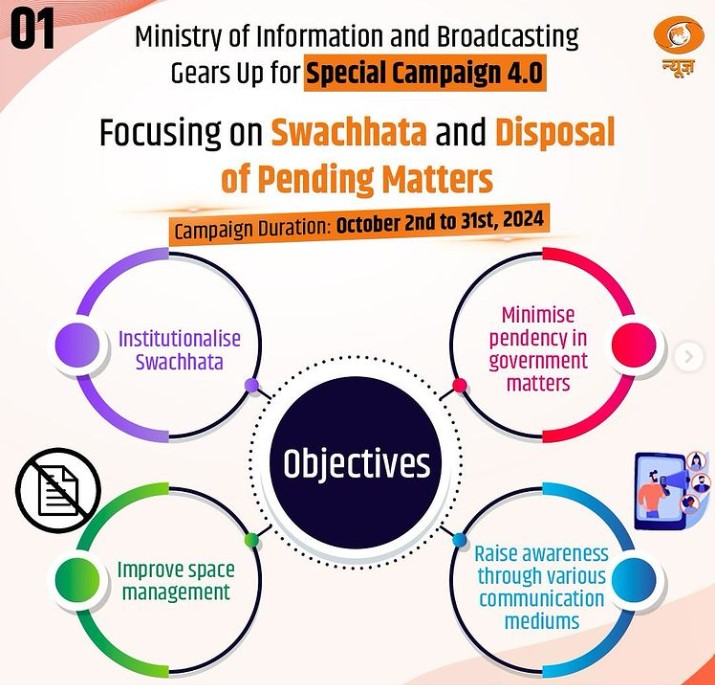
This initiative aligns with the vision of Prime Minister Narendra Modi and builds on previous successful campaigns from 2021 to 2023, which focused on digitization, waste management, and enhancing office spaces.
- Key objectives of Special Campaign 4.0 include:
- Creating Clean Office Spaces: The campaign aims to transform government offices into aesthetically pleasing and clutter-free spaces.
- Digital Empowerment: It seeks to enhance citizen engagement through digital platforms and improve service delivery, including reducing public grievance redressal timelines from 30 to 21 days.
- Wider Implementation: The campaign will encompass all ministries, departments, and public institutions across India and overseas.
- Record Management and Scrap Disposal: Focus on effective record management and the disposal of outdated files, with significant outcomes expected in office space optimization.
- Community and Environmental Impact: Initiatives like ‘Plastic Rakshasha’ aim to raise awareness about single-use plastics, while outreach efforts in Krishi Vigyan Kendras promote sustainable agricultural practices.
- Leadership and Team Building: The success of the campaign relies on strong leadership from ministers and senior officials, emphasizing teamwork and capacity building.
As India approaches its goal of Viksit Bharat by 2047, the Special Campaign 4.0 will play a pivotal role in enhancing governance, improving public trust, and driving towards a developed nation status.
Chapter 3: Achievements of Swachh Bharat Mission (SBM)
Phases of the SBM:
SBM-Grameen Phase I (2014-2019):
- Focused on constructing over 100 million toilets in rural areas.
- Emphasized community participation and behavioral change through awareness campaigns and infrastructure development.
- Resulted in significant health improvements in rural areas lacking sanitation facilities.
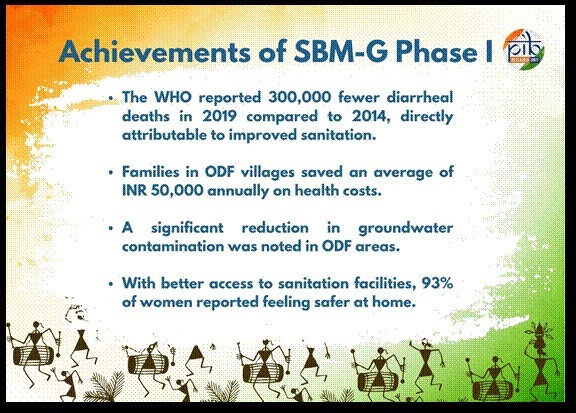
SBM-Grameen Phase II (2019-2025):
- Aims to sustain ODF status and manage solid and liquid waste by 2025 under the theme of ‘Sampoorn Swachhata’ (complete cleanliness).
- As of September 2024, over 5.87 lakh villages achieved ODF Plus status, with extensive solid and liquid waste management systems established.
- Construction of over 11.64 crore household toilets and more than 2.41 lakh community sanitary complexes, with an investment of Rs 1.40 lakh crores.
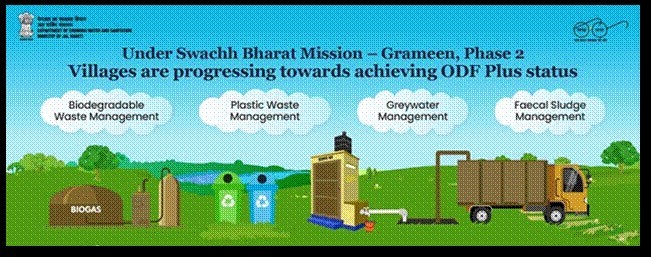
SBM-Urban:
- Launched concurrently with SBM-G on October 2, 2014, focusing on urban sanitation.
- Aims for 100% ODF status and scientific Solid Waste Management (SWM), promoting a people’s movement for cleanliness.
- Achievements include over 63 lakh household toilets and more than 6.3 lakh public toilets constructed.
Key Benefits of Swachh Bharat Mission (SBM):
The study analyzed data from 35 Indian states and 640 districts over a decade (2011-2020), focusing on infant mortality rate (IMR) and under-five mortality rate (U5MR) per thousand live births. Using two-way fixed effects regression models, the research controlled for various sociodemographic, wealth, and healthcarerelated confounders at the district level. This approach ensured a comprehensive analysis of the relationship between improvements in sanitation and reductions in child mortality.
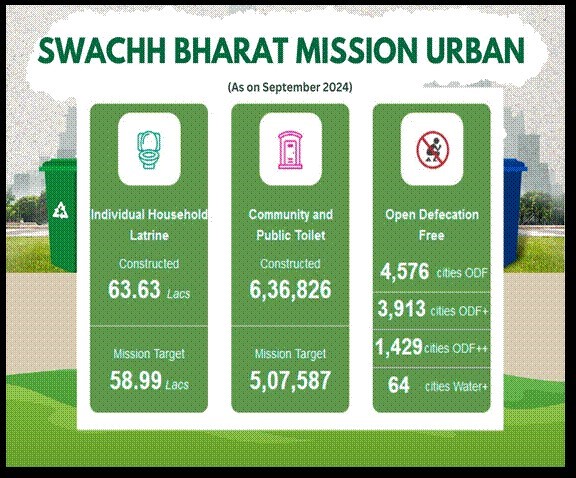
- Inverse Association Between Toilet Access and Child Mortality: The study identified a strong inverse relationship between toilet access and child mortality rates in India.
- Scale of Impact: Since the Swachh Bharat Mission (SBM) launched in 2014, over 117 million toilets have been constructed with a public investment exceeding Rs 1.4 lakh crore.
The analysis indicates that a 10-percentage point increase in district-level toilet access corresponds to a reduction in infant mortality rate (IMR) by 0.9 points and under-five mortality rate (U5MR) by 1.1 points.
- Notably, districts with over 30% toilet coverage saw reductions of 5.3 in IMR and 6.8 in U5MR per thousand live births, translating to an estimated annual saving of 60,000 to 70,000 infant lives.
- SBM’s Unique Approach: SBM’s strategy, which combines toilet construction with significant investments in Information, Education, and Communication (IEC) and community engagement, marks a departure from previous sanitation efforts. The program has shown a transformative impact on public health outcomes by reducing exposure to faecal-oral pathogens, thus lowering incidences of diarrhoea and malnutrition—key contributors to child mortality in India.
Swachhata Hi Seva (SHS) Campaign 2024
- Campaign Overview: The SHS campaign, celebrating a decade of initiative, will run from September 17 to October 2, 2024, under the leadership of Union Minister for Housing and Urban Affairs, Shri Manohar Lal.
- Objectives: The campaign focuses on mobilizing public participation (Jan Bhagidari), achieving sustainable cleanliness, and recognizing the role of sanitation workers (Safai Mitras).
- Achievements of SHS 2023:
- Over 109 crore individuals participated, with 53 crore contributing through ‘Shramdaan for Swachhata.’
- Key accomplishments included cleaning 7,611 beaches, revitalizing 6,371 riverbanks, and restoring over 1,23,840 public spaces.
- The SHS campaign highlights the significant impact of community engagement in enhancing sanitation and cleanliness in India.
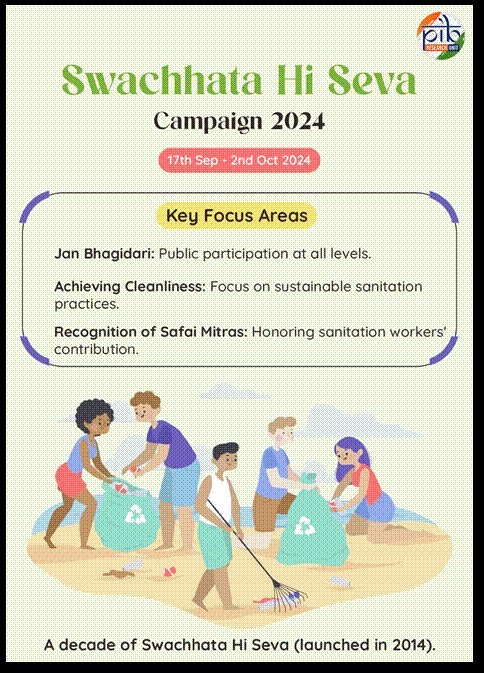
Chapter 4: Ganga Rejuvenation and Water Conservation
- The Ganga is central to India’s cultural and spiritual heritage, supporting 40% of the population and contributing significantly to the nation’s GDP.
- The river is sacred to Hindus, and its water quality is unique due to high dissolved oxygen content.
- Major spiritual events like the Kumbh Mela are held on its banks, attracting global gatherings.
- Industrialization, untreated sewage, and waste discharge have led to severe pollution in the Ganga, threatening its biodiversity and sustainability.
- Rapid urbanization and Western development models have exacerbated these challenges, combined with poor governance and infrastructure limitations.
Ganga Action Plan (GAP):
The Ganga Action Plan (GAP), launched in 1986 under PM Rajiv Gandhi, aimed to reduce pollution in the Ganga by setting up sewage treatment plants and controlling industrial effluents.
- Despite completing 652 projects and building 35 treatment plants, the plan faced challenges like inadequate infrastructure, poor governance, and limited public awareness.
- Its short-term improvements were not sustained, but GAP laid the foundation for future initiatives like the Namami Gange Programme, highlighting the need for stronger public involvement in river conservation.
Namami Gange Mission:
It was launched in June 2014 with a budget of ₹20,000 crore, is an integrated conservation mission aimed at reducing pollution and rejuvenating the Ganga River.

- It focuses on the twin goals of restoring the river’s continuous flow (Aviral Dhara) and clean flow (Nirmal Dhara), along with protecting geological and ecological features.
- The Ministry of Jal Shakti oversees its implementation.
- Key initiatives include the construction of 815 sewage treatment plants, river-surface cleaning, afforestation, biodiversity conservation, and public awareness.
- Community engagement is promoted through platforms like Ganga Vichar Manch, and several projects on riverfront development and aquatic species restoration have been undertaken.
- By 2021, the program achieved significant milestones, including the approval of 200 sewerage projects worth ₹31,810 crore, with 116 implemented successfully.
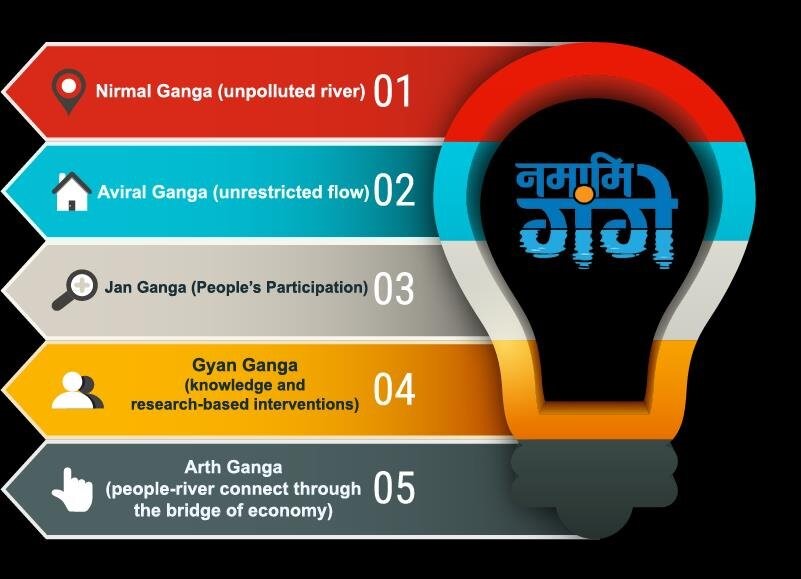
Challenges in Cleaning the River Ganga
- Sewage Treatment: Delays in new sewage treatment projects due to land acquisition and procedural hurdles, coupled with poor performance of Sewage Treatment Plants (STPs) and inadequate sewerage networks in cities, allow industries to easily dispose of waste into common drains, exacerbating pollution due to lax regulatory enforcement.
- Restoring the Flow: The Ganga’s self-purifying capacity is compromised, with sufficient flow essential for purification occurring only during monsoons.
- Decreased water flow results in reduced velocity and increased siltation, further diminishing the river’s ability to self-purify.
- Sludge Control: Although the Swachh Bharat Mission (SBM) has improved containment of human waste in Ganga Gram areas, safe disposal of faecal sludge remains a major challenge, as it is a more significant pollutant than sewage, having a biochemical oxygen demand (BOD) of 15,000-30,000 mg/l compared to 150-300 mg/l for sewage.
- Cost Overruns: Increased costs due to delays in project implementation and ineffective financial management impact the overall effectiveness of the cleaning initiatives.
- Governance Issues: Lack of coordination among various ministries hinders the execution of Ganga Action Plans, resulting in delays and budget overruns.
Solutions and Way Forward:
- Establishing an Autonomous Agency: The National Ganga Council (NGC) should operate as an autonomous body independent of government influence. It should be composed of environmental experts with extensive knowledge of the Ganga rather than solely bureaucrats, ensuring more relevant experience and effective decision-making.
- Enhancing Water Flow: The designs of hydroelectric projects should be modified to minimize water consumption, thereby increasing water flow downstream. Although this may increase project costs, it is essential for the long-term preservation and restoration of the Ganga’s self-purifying capabilities.
- Improving Coordination: The National Ganga Council should convene more frequently to enhance collaboration among ministries and between the Union and State Governments, ensuring a more cohesive approach to Ganga rejuvenation.
- Decentralization: Critics suggest that the current program is overly centralized, primarily driven by the Union Government. Greater involvement of State and Local Governments through a bottom-up approach can lead to more effective implementation and local ownership of the cleaning initiatives.
- Initiatives by the National Mission for Clean Ganga (NMCG): The NMCG should pursue various initiatives for Ganga rejuvenation, such as establishing decentralized sewage treatment plants (dSTPs), developing local water storage solutions (like ponds and wetlands), protecting ‘river corridors,’ and restoring base flow through groundwater recharge methods.
Chapter 5: Construction and Demolition: Circular Economy Solutions
India’s construction sector significantly contributes to the economy but generates a substantial amount of solid waste, with Construction and Demolition (C&D) waste making up one-third of total waste.
- Implementing circular economy solutions can effectively reduce C&D waste and promote sustainability. The Swachh Bharat Mission, launched in 2014, aims for a cleaner India through sustainable waste management, which includes:
- Reduce: Minimizing waste generation.
- Reuse: Extending product lifespan.
- Recycle: Converting waste into resources.
- Recover: Reclaiming energy and materials.
- Dispose: Safe disposal of residual waste.
Linear and Circular Economic Systems
The linear economic system follows a ‘take-make-waste’ model, extracting raw materials to produce goods that are discarded as waste at the end of their lifecycle.
- This unsustainable approach leads to resource depletion, environmental degradation, and significant waste generation, exacerbated by rising population and urbanization.
- In contrast, the circular economy aims to minimize waste and pollution through a ‘closed-loop system.’ It focuses on extending product life, maximizing reuse and recycling, and reducing the use of virgin resources.
- This approach ensures that materials remain in use, recycling any unavoidable waste, and considers the environmental and social impacts of economic activities.
Importance of the Construction Sector in India
- The construction sector in India accounts for around 20% of total material demand and contributes over 8% to GDP.
- It is expected to become the third largest globally, driven by rapid urbanization and a housing shortage projected to reach 38 million units by 2030. India needs to build 700-900 million square meters of new commercial and residential space annually.
- Government initiatives like the Smart Cities Mission and the Swachh Bharat Mission are enhancing urban infrastructure investment, with an estimated need for Rs 77 lakh crore (US$ 1.2 trillion) by 2030.
- However, the sector generates significant construction and demolition (C&D) waste, comprising onethird of total solid waste and one-fourth of municipal solid waste.
- Recycling C&D waste can reduce greenhouse gas emissions by 40% compared to virgin materials, presenting economic and environmental benefits
General Composition of Construction and Demolition (C&D) Waste
India generates approximately 12 million tonnes of Construction and Demolition (C&D) waste annually, accounting for 20-25% of total municipal solid waste (MSW).
- The composition of C&D waste varies by city and region, but a typical urban mix includes: Soil, sand, and gravel: 47%, Bricks and masonry: 32%, Concrete: 7%, Metal: 6%, Wood: 3% and Others: 5%.
- Materials like bricks, tiles, wood, and metals are often sold for reuse or recycling, while the remaining waste typically ends up in landfills.
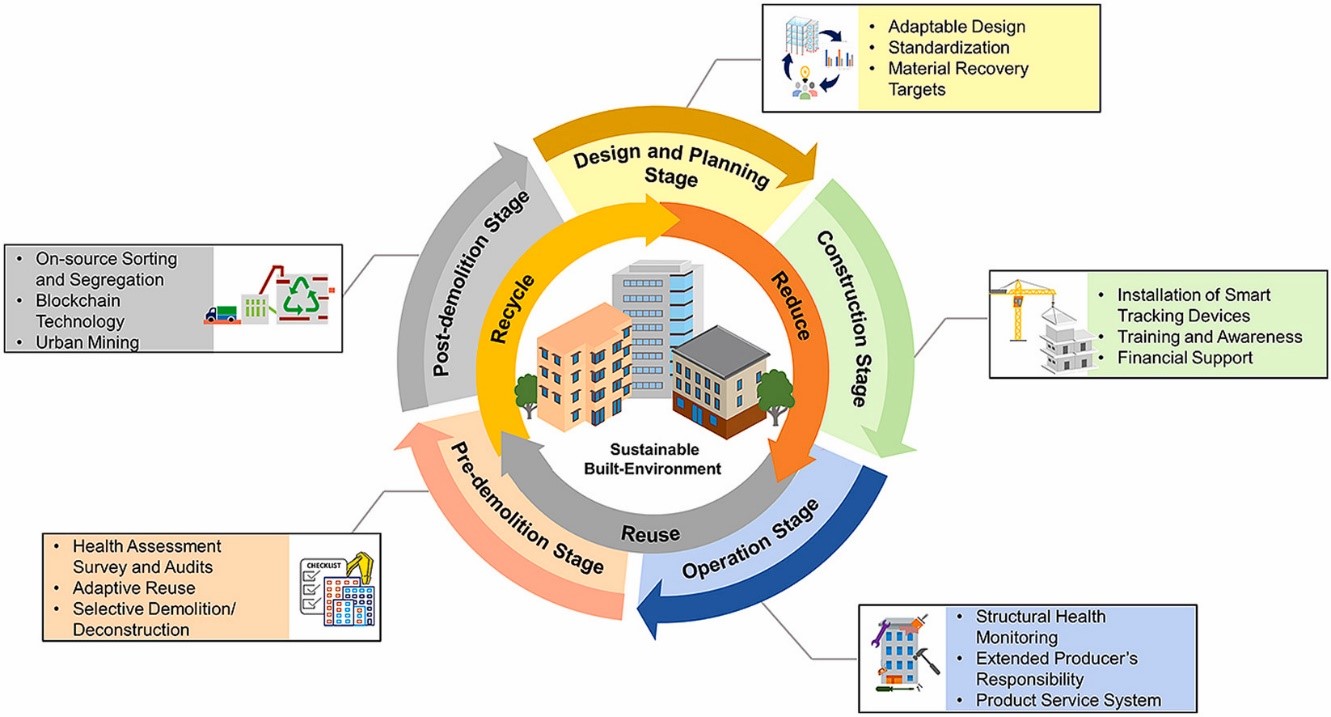
Potential of C&D Waste for Circularity
Managing Construction and Demolition (C&D) waste effectively offers several environmental and societal benefits:
- Reducing environmental impact: Recycling C&D waste lowers the demand for natural resources, minimizing the environmental damage from extraction. It also cuts greenhouse gas emissions by reducing reliance on landfilling and incineration.
- Reducing waste disposal space: Proper C&D waste management decreases the need for disposal space, mitigating safety risks associated with landfills.
- Reducing raw material imports: Reusing and recycling C&D waste reduces dependence on imported raw materials for construction.
- Conserving resources: Managing C&D waste helps conserve vital resources and minerals.
- Promoting recycled products: Effective C&D waste management encourages the use of recycled materials in construction and infrastructure projects, supporting sustainability.
Conclusion
The circular economy in the construction sector reduces raw material use, waste, and costs, while improving construction quality and sustainability. By 2050, adopting circular practices could generate Rs 4.9 lakh crore (US$ 76 billion) in annual benefits and significantly cut resource use and greenhouse gas emissions. The C&D Waste Management Rules, 2016, support this shift, making it an ideal time for India to embrace circular economy principles across sectors.
Chapter 6: India’s Biofuel Revolution
India is experiencing a transformative shift in its energy landscape, with biofuels emerging as a crucial component of its renewable energy strategy.
- Biofuels are renewable fuels made from organic materials such as plant biomass, vegetable oils, animal fats, and agricultural waste.
- Unlike fossil fuels, which take millions of years to form, biofuels can be replenished quickly, making them a sustainable energy source and a viable alternative to petroleum-based fuels like gasoline and diesel.
Biofuels types:
1. Ethanol: Produced from crops like corn and sugarcane, ethanol is commonly used as a gasoline additive to reduce emissions and enhance fuel efficiency.
2. Biodiesel: Derived from vegetable oils or animal fats, biodiesel can directly replace conventional diesel in vehicles without major modifications.
- As the world’s third-largest energy consumer, India’s commitment to achieving sustainable energy through biofuels is not only vital for national energy security but also aligns with global efforts to combat climate change.
- India’s biofuel journey began in the early 2000s, marked by the initiation of a 5% ethanol blending pilot program in 2001.
- The National Policy on Biofuels, introduced in 2009 and revised in 2018 and 2022, has set ambitious targets, including a goal of 20% ethanol blending in petrol by 2025. This policy framework has laid the groundwork for the promotion of diverse biofuels, including those from non-food feedstocks.
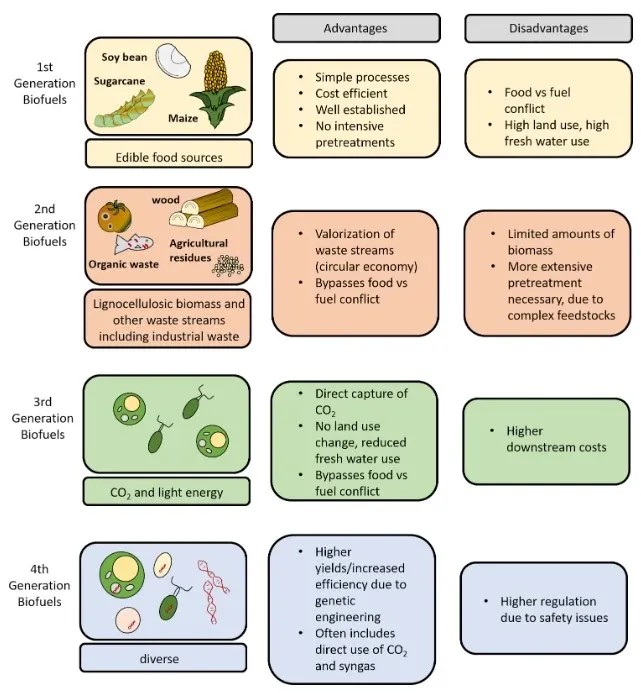
- Additionally, initiatives like Make in India are fostering domestic biofuel production, creating investment and innovation opportunities. These efforts are part of India’s broader goals of achieving energy independence by 2047 and carbon neutrality in the coming decades.
Current Biofuel Landscape
- India has approximately 500 million tons of biomass available annually, with 120 to 150 million tons surplus for energy production.
- Biofuels contribute about 12.83% of total renewable energy generation, highlighting their significance in reducing dependence on fossil fuels.
- Major public sector undertakings, such as Indian Oil Corporation (IOC) and Bharat Petroleum Corporation Limited (BPCL), are investing heavily in biofuel research and production.
- Initiatives like the Pradhan Mantri JI-VAN Yojana encourages private sector participation in sustainable aviation fuel and second-generation biofuel production.
Challenges Facing the Biofuel Sector
- Dependence on First-Generation (1G) Ethanol: India’s target of achieving 20% ethanol blending with petrol (E20) by 2025-26 is primarily reliant on 1G ethanol produced from sugarcane and food grains, which raises sustainability concerns.
- Supply Chain Bottlenecks: The contribution of Second-Generation (2G) ethanol to the E20 target is limited due to challenges in the feedstock supply chain and difficulties in scaling up production.
- Food Security Concerns: With stagnating crop yields and the anticipated impacts of global warming on agriculture, India’s strategy for meeting blending targets cannot solely rely on surplus crop production.
- Groundwater Depletion: A recent study by the University of Michigan indicates that groundwater depletion rates could triple between 2040 and 2081, posing a significant challenge to sustainable biofuel production.
- Increase in Greenhouse Gas Emissions: The increase in greenhouse gas emissions from agriculture for fuel production raises sustainability concerns and contradicts environmental goals.
- Reliance on Sugarcane: The focus on sugarcane as a primary feedstock is influenced more by government policies than by market dynamics, complicating diversification efforts.
- Economies of Scale: Achieving economies of scale while addressing the energy needs and costs of biomass collection and transportation over long distances remains a significant challenge.
Prospects and Opportunities
- Government Initiatives: The Pradhan Mantri JI-VAN Yojana, with an allocation of INR 1,969 crore, aims to support integrated bioethanol projects using lignocellulosic biomass.
- Global Collaborations: India’s leadership in the Global Biofuels Alliance fosters international cooperation, enhancing biofuel expertise and promoting global adoption.
- Economic Growth: A robust biofuel industry can create jobs, stimulate investments, and support rural economies, contributing significantly to national GDP.
Recommendations
- Policy Integration: Aligning policies across sectors can create a supportive environment for biofuel development.
- R&D Investment: Prioritizing research on second and third-generation biofuels can bridge technological gaps.
- Collaborative Innovation: Partnerships between industry and academic institutions can drive innovation and address socio-economic implications.
Conclusion
India stands at the cusp of a biofuel revolution, with the potential to achieve its blending targets and emerge as a global hub for biofuel research and innovation. By balancing the opportunities and challenges, India can significantly reduce its carbon footprint, enhance energy security, and drive economic growth. The call to action is clear: stakeholders must champion innovation, foster collaborations, and ensure that the biofuel sector flourishes, setting a global benchmark in renewable energy endeavors.
Mains Practice Question: - (in around 250 words)
Q1. Discuss the role of biofuels in India’s energy security and environmental sustainability. What are the challenges faced in their production and utilization?
Q2. Evaluate the impact of the Swachh Bharat Mission on public health and sanitation in India. What challenges remain in achieving the mission’s objectives?
Q3. Discuss the concept of a circular economy and its significance in achieving sustainable development goals. How does it differ from the traditional linear economy model?